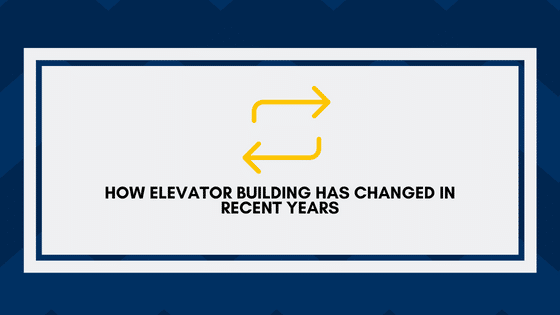If you’ve been paying attention, you may have noticed that elevator building has changed a lot in recent years.
New technologies and improved methods have made it possible to build taller, faster, and more efficiently than ever before. In this blog post, we’ll take a look at some of the ways elevator building has changed and how those changes have affected the industry as a whole.

Elevator Building Methods Have Improved.
One of the biggest changes in elevator building in recent years is the methods used to build them.
New technologies and improved methods have made it possible to build taller, faster, and more efficiently than ever before. For example, prefabricated modules are now commonly used in the construction of elevators.
This means that instead of being built on site, elevators are now often built in factories and then assembled on site. This results in less waste, fewer errors, and a quicker overall construction time.

Elevator Building Standards Have Changed.
Another way elevator building has changed is in the standards that are used to construct them. In the past, elevators were built to lower standards and as a result were often less reliable and safe.
However, in recent years there have been a number of high-profile accidents involving elevators that have led to calls for improved safety standards. As a result, elevator builders are now held to much higher standards when it comes to the safety and reliability of their products.
Another change that has occurred in elevator building is that buildings are getting taller. Thanks to advances in engineering and construction techniques, it is now possible to build taller buildings than ever before.
This has resulted in a need for taller elevators that can travel at higher speeds without sacrificing safety or reliability. To meet this demand, elevator builders have had to develop new technologies and methods for constructing taller elevators that can safely transport people to the top of even the tallest buildings.

Elevator Buildings Are Getting Taller
Most people take elevators for granted nowadays. They are a common sight in both commercial and residential buildings, and they make it possible to move between floors quickly and easily. However, elevators have not always been so commonplace. In fact, early elevator buildings were quite rare. Let’s take a look at how elevator buildings have evolved over time.
The first elevator building was constructed in New York City in 1857. It was a five-story structure, and the elevator was powered by steam. The use of steam power meant that the elevator could only be used during daytime hours when the boiler was lit. This early elevator was not very popular, and it wasn’t until 1873 that the first passenger elevator was installed in a public building.
The early 20th century saw the rise of the skyscraper, and with it came a new need for efficient ways to move large numbers of people between floors. The first multiple-passenger elevator was built in 1902, and it could carry up to 1,400 pounds at a time. This type of elevator soon became the norm in office buildings and hotels.
It’s clear that elevator building has changed a lot in recent years. New technologies and improved methods have made it possible to build taller, faster, and more efficiently than ever before. These changes have had a major impact on the industry as a whole and will continue to do so in the years to come.

Today’s elevators are much more energy-efficient than their predecessors.
Elevator technology has continued to evolve over the years. Today’s elevators are much more energy-efficient than their predecessors, and they can travel at much higher speeds. Some newer buildings even have ” destination control ” systems that allow users to input their desired floor before entering the elevator lobby. This eliminates the need for stops on intermediate floors, which saves time and improves efficiency.
Elevator buildings are now a common sight in cities all over the world. However, this was not always the case. Early elevator buildings were quite rare, and early elevators were slow and inefficient by today’s standards. But as technology has progressed, so too have elevators. Today’s elevators are faster, more energy-efficient, and more user-friendly than ever before.

Island Elevator is Ready to Help!
Island Elevator is here to help you understand all facets of your Elevator Repair, Maintenance, & Modernization costs in the new year. Our team is here to help ensure your home and business vertical transportation equipment receive the regularly scheduled maintenance necessary to help you avoid a major catastrophe, reduce the possibility of a costly repair, and ensure the safety of your passengers, tenants, and family.

